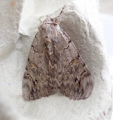2022 Annual Report for: Erebidae / Erebinae
For species seen in 2022 that had less than or equal to 100 records, full details are included; for more common species, the earliest, latest and highest count by vice-county are shown. The narrative for each species is taken from the main Hantsmoths website, and it is possible that some information on abundance and occurrence can get out of date, as it is impossible to keep up with all changes; however it should give a good introduction to each species. The tables in each species account summarise the previous status, and that for the current year.
For the maps, all records prior to 2022 are shown by a blue dot (the larger the dot, the more recent), with the current year's records shown in red. As previous records are superimposed on any report for 2022, new sites have greater emphasis (i.e. will show as 'more red').
In the species accounts, an asterisk next to a location indicates a new 10km square record; earliest ever dates are highlighted in orange, and latest ever in red. Initials in the species accounts refer to the recorders listed here. Please get in touch if you identify any omissions or errors, in particular if you have records that have yet to be submitted. Details of how to submit records can be found here.
72.076 [B&F: 2451] Clifden Nonpareil (Blue Underwing) Catocala fraxini (Linnaeus, 1758) - Recent colonist
A species that was a rare immigrant, temporarily established in Kent and the Norfolk Broads in the past, but which since c. 2005 now appears be making a comeback as a resident species in places. In Hampshire and on the Isle of Wight historically a rare immigrant with up to 1995 about twenty records altogether. Since 2006, the species has started to be recorded more regularly, for example, at Ventnor and Totland on the Island, and at Brockenhurst in the New Forest, and sightings have increased year on year. It is almost certainly resident in a number of localities across southern England (including our area) and while there is the possibility that some of these individuals may have originally originated from deliberate release of captive stock, it is most likely that most populations originate from migrants remaining to breed in this country. Wingspan male 84-100 mm, female 98-112 mm. The original name for this species, Blue Underwing, sums up the identification criteria nicely! Larva feeds on Aspen, no evidence of breeding in the UK.
Records prior to 2022
| Vice County | #Records | #Individuals | First Record | Last Record |
|---|---|---|---|---|
| 10 | 110 | 115 | 1866 | 2021 |
| 11 | 248 | 255 | 1871 | 2021 |
| 12 | 122 | 131 | 1850 | 2021 |
2022 records
| Vice County | #Records | #Individuals | Max Quantity |
|---|---|---|---|
| 10 | 6 | 6 | 1 |
| 11 | 21 | 18 | 2 |
| 12 | 3 | 3 | 1 |
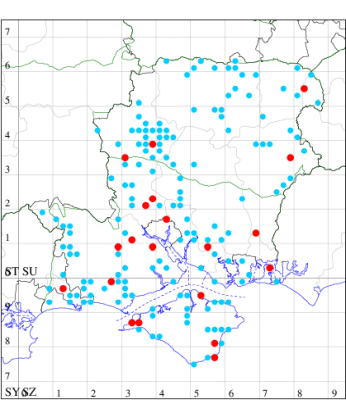
Records by year
Records by week (adult)
Records by week (larval)
Record Details
VC10: Totland, one, 17 Oct (RTer); Freshwater, one, 21 Sep (PBar); Bonchurch, one, 21 Sep (JHa); Shanklin, one, 16 Sep; one, 18 Sep; Osborne Wood, one, 14 Sep (IOu);
VC11: Lyndhurst, one, found dead, 03 Nov (IHan); Marchwood, one, 18 Sep; one, 03 Oct (CTha); Woodlands, NF, one, 25 Oct (RBW); Romsey, one, 02 Oct (MJB); two, 19 Sep; one, 28 Sep; one, 18 Oct (NRJ); Broughton, one, 02 Sep (GCE); Swaythling, Southampton, one, 27 Aug (MEdg); Botley Wood, one, field observation, 23 Sep (RJD, MLO, DWal, KJW); Lovedean, one, 27 Sep (ARJ); Northney, Hayling Island, present, 22 Sep; present, 30 Sep; present, 04 Oct; present, 08 Oct (JWP); Hurn, one, 22 Sep; one, 03 Oct; one, 15 Oct; one, 28 Oct (MJef); Sway, one, 23 Aug (SKee);
VC12: Chilbolton, one, 19 Sep (GCE); Whitehill, one, 12 Oct (ASto); Fleet Pond, one, to sugar, 14 Aug (MHals)
72.078 [B&F: 2452] Red Underwing Catocala nupta (Linnaeus, 1767) - Common
Common in woodland, parks, scrub, marshes and gardens throughout much of England and Wales. In Hampshire and on the Isle of Wight The most widely distributed of the Catocala group, but less so than formerly. Not particularly attracted to light, which may result in it being under-recorded, but it isn't seen by day resting on tree-trunks in the profusion of a few decades back. Wingspan 75-94 mm. The most likely confusion species are the very much less common Light Crimson Underwing C. promissa and Dark Crimson Underwing C. sponsa, in both of which the subterminal line is strongly dentate, and Rosy Underwing C. electa, in which the forewing is uniformly pale grey, without ochreous tint, the reniform stigma less clearly defined and the postmedian line more strongly dentate subcostally, with a costally directed tooth (MBGBI Vol 10). Larva feeds on Black Poplar, White Poplar, Aspen, Crack Willow and White Willow, over-wintering as an egg.
Records prior to 2022
| Vice County | #Records | #Individuals | First Record | Last Record |
|---|---|---|---|---|
| 10 | 119 | 90 | 1856 | 2021 |
| 11 | 958 | 971 | 1950 | 2021 |
| 12 | 265 | 227 | 1951 | 2021 |
2022 records
| Vice County | #Records | #Individuals | Max Quantity |
|---|---|---|---|
| 10 | 11 | 8 | 1 |
| 11 | 18 | 15 | 2 |
| 12 | 5 | 5 | 2 |
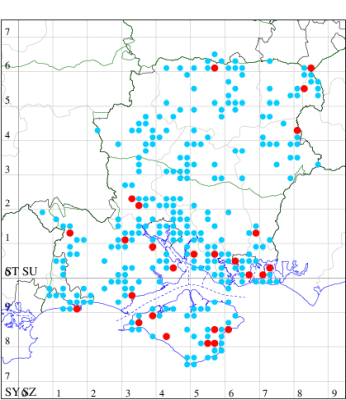
Records by year
Records by week (adult)
Records by week (larval)
Record Details
VC10: Freshwater, one, 19 Sep (PBar); Cranmore, present, 04 Aug (CHic); Brighstone, one, 15 Aug (AMas); Wroxall, one, 02 Sep (JRB); Shanklin, one, 30 Aug; one, 21 Sep; one, 26 Sep (IOu); Alverstone, one, 30 Aug; one, 02 Oct (DFai); Sandown, present, field observation, 09 Sep (SPee); present, field observation, 25 Aug (iNat);
VC11: Fordingbridge, one, 01 Oct (SCT); Marchwood, one, 11 Aug; one, 23 Aug; two, 01 Oct (CTha); Woodlands, NF, present, field observation, 15 Sep (RBW); Stanbrige Earls, one, indoors, 31 Aug (JRM); Romsey, present, field observation, 18 Sep (iNat); Blackfied, one, field observation, female at rest on wall, 30 Jul (PGS); Locks Heath, one, 30 Jul (GBat); Fareham, one, 19 Sep (MLO); Portchester, one, 31 Aug (DH-J); Portsmouth, one, 22 Sep (IRT); Lovedean, one, 27 Aug (ARJ); Hayling Island, present, field observation, 10 Aug (iNat); Northney, Hayling Island, present, 26 Sep (JWP); Hengistbury Head, one, 20 Oct (RPH); Lymington, one, 02 Sep (PRD);
VC12: Axmansford, one, field observation, 18 Jul (ACB); Farnham, present, 01 Aug (iNat); Fleet Pond, one, to sugar, 02 Aug (MHals); Blackwater, two, swept, 10 Jul; one, sugaring, 13 Jul (BGD)
72.079 [B&F: 2453] Rosy Underwing Catocala electa (Vieweg, 1790) - Vagrant/Accidental
Rare immigrant from southern Europe, appearing in southern England irregularly in the 20th Century. In the past two decades occurrences have been almost annual and signs that it may be on the verge of local colonisation. In our area, there have been six recorded on the Isle of Wight since 2009. Surprisingly, Hampshire had to wait until 2022 for the first mainland record, and in line with national trends it appears to becoming more regular on an annual basis. Wingspan 65-80 mm. The main confusion species are the very much more common Red Underwing C. nupta, which has the forewing more mottled and fasciae less deeply dentate, hindwing with dark marginal band somewhat narrower and its distal edge more irregular, and Dark Crimson Underwing C. sponsa, which has the forewing darker with reniform stigma large and pale (MBGBI Vol 10). Larva feeds on Grey Willow, Crack Willow, Black Poplar and White Poplar.
Records prior to 2022
| Vice County | #Records | #Individuals | First Record | Last Record |
|---|---|---|---|---|
| 10 | 5 | 5 | 2009 | 2021 |
2022 records
| Vice County | #Records | #Individuals | Max Quantity |
|---|---|---|---|
| 10 | 1 | 1 | 1 |
| 11 | 1 | 1 | 1 |
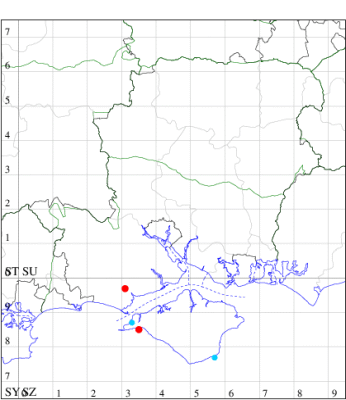
Records by year
Records by week (adult)
Records by week (larval)
Record Details
VC10: Freshwater Bay, one, 21 Aug (SDav);
VC11: New Vice-county Record: Lymington*, one, 20 Aug (ASH)
72.081 [B&F: 2455] Dark Crimson Underwing Catocala sponsa (Linnaeus, 1767) - Nationally Rare
A vulnerable Red Data Book species, in ancient oak woodland in parts of New Forest, also appearing as a migrant in the south, a priority species under the UK Biodiversity Action Plan. Confined as a breeding species to the New Forest in Hampshire. Formerly there were colonies in south Wiltshire until at least 1949. Occasional specimens reported from elsewhere in southern England, including several from north Hampshire and the Isle of Wight, are believed to be migrating or dispersing individuals. Wingspan 58-78 mm. The most likely confusion species are Red Underwing C. nupta and Light Crimson Underwing C. promissa, which see for differences. Larva feeds on Pedunculate Oak and Sessile Oak, over-wintering as an egg.
Records prior to 2022
| Vice County | #Records | #Individuals | First Record | Last Record |
|---|---|---|---|---|
| 10 | 17 | 17 | 1893 | 2021 |
| 11 | 286 | 503 | 1881 | 2021 |
| 12 | 27 | 36 | 1979 | 2021 |
2022 records
| Vice County | #Records | #Individuals | Max Quantity |
|---|---|---|---|
| 10 | 1 | 1 | 1 |
| 11 | 6 | 6 | 1 |
| 12 | 3 | 7 | 5 |
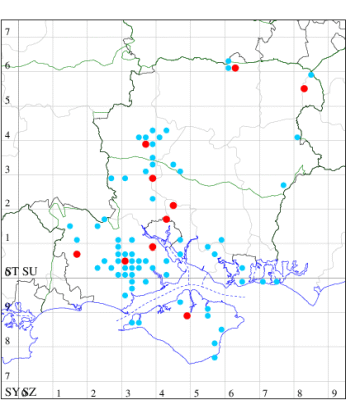
Records by year
Records by week (adult)
Records by week (larval)
Record Details
VC10: Newport*, one, 20 Jul (DPl);
VC11: North Poulner, NF*, one, 25 Aug (DBra); Pig Bush, NF, one, 29 Aug (PCut); Marchwood, one, 27 Aug (CTha); Kings Somborne, one, 27 Jul (GCE); Swaythling, Southampton, one, 02 Aug (MEdg); Allbrook, one, 23 Aug (SIng);
VC12: Wherwell, one, 04 Aug (GCE); Pamber Forest, one, 15 Aug (GJD); Fleet Pond, five, to sugar, 01 Aug (MHals)
72.082 [B&F: 2454] Light Crimson Underwing Catocala promissa ([Denis & Schiffermüller], 1775) - Nationally Rare
A once rare but now increasing species, associated with ancient oak woodland in parts of southern England, a priority species under the UK Biodiversity Action Plan. At the turn of the century it was very much confined to the New Forest and two large woodlands in south Wiltshire, with occasional records from elsewhere in southern England, which may have resulted from internal dispersal or migration from the continent. In Hampshire and on the Isle of Wight the 21st century has seen increasing scattered records throughout the county, still centred on the New Forest but now appearing well away from the historical locus here, likely to be a result of increased immigration from across the Channel and localised breeding in new locations. Wingspan 50-66 mm. The most likely confusion species are Red Underwing C. nupta and Dark Crimson Underwing C. sponsa, which see for differences. Larva feeds on Pedunculate Oak and Sessile Oak, over-wintering as an egg.
Records prior to 2022
| Vice County | #Records | #Individuals | First Record | Last Record |
|---|---|---|---|---|
| 10 | 19 | 20 | 1856 | 2021 |
| 11 | 799 | 1076 | 1800 | 2021 |
| 12 | 46 | 42 | 1800 | 2021 |
2022 records
| Vice County | #Records | #Individuals | Max Quantity |
|---|---|---|---|
| 10 | 2 | 1 | 1 |
| 11 | 52 | 56 | 2 |
| 12 | 15 | 19 | 5 |
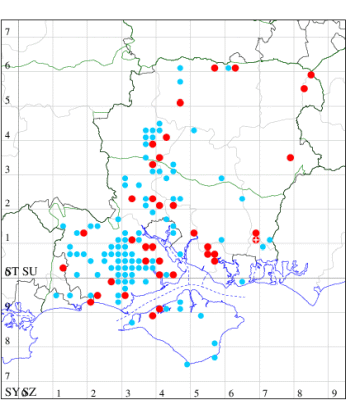
Records by year
Records by week (adult)
Records by week (larval)
Record Details
VC10: Cranmore, present, 06 Aug (CHic); Lower Hamstead, one, field observation, 26 Jul (KRyl);
VC11: St Leonards, one, 23 Jul; one, 30 Jul (SDut); Hasley, NF, one, 19 Jul (AMD); Pig Bush, NF, one, sugaring, to sugar on oak , 20 Aug (PCut); Marchwood, one, 23 Jul (TDCh); one, 23 Jul; one, 10 Jul; one, 12 Jul; one, 14 Jul; two, 27 Jul; one, 31 Jul; one, 04 Aug; one, 23 Aug (CTha); Woodlands, NF, two, 06 Aug (CJon); Stanbrige Earls, one, 30 Jul (JRM); Romsey, two, 21 Jul; one, 31 Jul; one, 17 Aug; one, 21 Aug (NRJ); Crawley, one, 30 Jul (GCE); Needs Ore NNR, one, 20 Aug (CNB); Dibden Purlieu, one, 07 Aug; one, 08 Aug (RAC); Blackfield, one, 25 Jul; one, 06 Aug (SJJ); Vale Park, Chandler's Ford, one, 12 Jul (KArb); Allbrook, one, 21 Jul; one, 27 Jul; one, 09 Aug; two, 10 Aug; one, 27 Aug (SIng); Fareham, one, 31 Jul (IMcP); Funtley, one, 21 Jul; one, 30 Jul; one, 24 Aug; one, 03 Sep (TDC); Fareham, one, 02 Aug (ADT); one, 09 Aug (MLO); one, retained, 03 Aug (KJW); Botley, one, 14 Aug; one, 21 Jul (SLB); Havant, larva, one, field observation, 15 May (AMac det. MJW); Lovedean, one, 24 Jul; one, 27 Jul; one, 02 Aug (ARJ); Highcliffe, one, 27 Jul (NMat); New Milton, one, 08 Aug (MBar); Sway, one, 23 Aug (SKee); Pennington, one, 19 Jul; one, 20 Jul; one, 22 Jul; one, 03 Aug (RFC);
VC12: Chilbolton, one, 07 Aug; Crawley, one, 22 Jul; Barton Stacey, one, 22 Aug; Cole Henley, one, 23 Aug; one, 05 Jul (GCE); Smithley's Copse, Axmansford, one, field observation, flew from bramble and landed on tree trunk, 18 Jul; Axmansford, one, 30 Jul; Great Haughurst Copse, Axmansford, one, 16 Aug (ACB); Pamber Forest, one, 10 Jul; one, 15 Aug (GJD); Whitehill, one, 25 Jul (ASto); Fleet Pond*, five, to sugar, strong population in 2022 and 2023, 01 Aug (MHals); Blackwater*, one, 19 Jul; one, 24 Jul; one, 02 Aug (BGD)
72.083 [B&F: 2463] Burnet Companion Euclidia glyphica (Linnaeus, 1758) - Common
Common in grassland, flower meadows, downland, woodland rides, roadside verges and embankments throughout England, Wales and Ireland. Widespread and common in Hampshire and on the Isle of Wight. Wingspan 28-32 mm. Unmistakable. Day-flying. Larva feeds on White and Red Clover, Common Bird's-foot Trefoil, Black Medick, Lucerne and Tufted Vetch, over-wintering as a pupa.
Records prior to 2022
| Vice County | #Records | #Individuals | First Record | Last Record |
|---|---|---|---|---|
| 10 | 107 | 93 | 1880 | 2021 |
| 11 | 559 | 948 | 1950 | 2021 |
| 12 | 1203 | 3478 | 1951 | 2021 |
2022 records
| Vice County | #Records | #Individuals | Max Quantity |
|---|---|---|---|
| 10 | 7 | 14 | 5 |
| 11 | 53 | 83 | 5 |
| 12 | 111 | 186 | 6 |
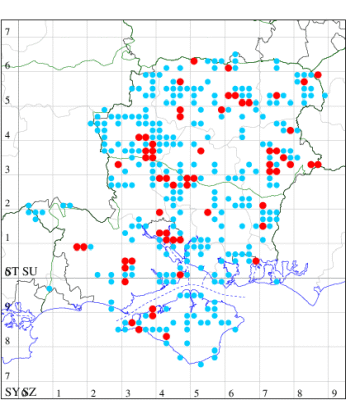
Records by year
Records by week (adult)
Records by week (larval)
Record Summary
VC10: Earliest: Cranmore, 16 May, 1 (NKow) Latest: Afton Down, 18 Jun, 1 (IOu) Max count: Brook Down, 28 May, 5 (ABut)
VC11: Earliest: Deacon Hill, 13 May, 1 (FHay) Latest: Calshot, 25 Jun, 1 (PGS) Max count: Pitt Down, 10 Jun, 5 (AJB, LB)
VC12: Earliest: Magdalen Hill Down NR, 18 Apr, 1 (AJB, LB) Latest: Morn Hill, Winchester, 04 Jul, 1 (CRB) Max count: Leckford Old Golf Course, 22 May, 6 (GCE)
72.084 [B&F: 2462] Mother Shipton Callistege mi (Clerck, 1759) - Common
Common in open grassland, heathland, moorland, woodland rides and roadside verges throughout much of England, Wales and southern Scotland. In Hampshire and on the Isle of Wight this diurnal species is locally fairly common on downland, in rough grassland and waste places where clovers and trefoils or lucerne occur. Wingspan 30-34 mm. Day-flying. Named after old Mother Shipton, a 16th-century Yorkshire witch. Larva feeds on White Clover, Red Clover, Hare's-foot Clover, Black Medick, Lucerne and Common Bird's-foot Trefoil, over-wintering as a pupa.
Records prior to 2022
| Vice County | #Records | #Individuals | First Record | Last Record |
|---|---|---|---|---|
| 10 | 149 | 118 | 1951 | 2021 |
| 11 | 550 | 615 | 1951 | 2021 |
| 12 | 549 | 677 | 1951 | 2021 |
2022 records
| Vice County | #Records | #Individuals | Max Quantity |
|---|---|---|---|
| 10 | 8 | 10 | 3 |
| 11 | 57 | 75 | 3 |
| 12 | 53 | 95 | 17 |
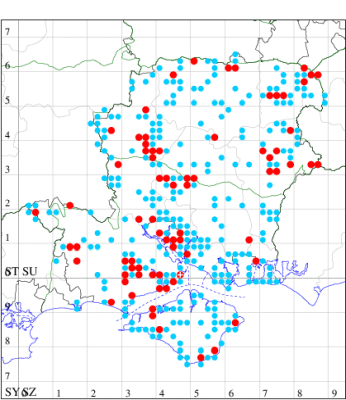
Records by year
Records by week (adult)
Records by week (larval)
Record Summary
VC10: Earliest: Mottistone, 04 May, 1 (NKow) Latest: Cranmore, 28 May, 1 (NKow) Max count: Brook Down, 28 May, 3 (ABut)
VC11: Earliest: Lord's Wood, Rownhams, 08 May, 1 (AJB) Latest: Tom Tiddlers, Calshot, 07 Sep, 2 (RAC) Max count: Broughton Down HIWWT NR, 02 Jun, 3 (BRob)
VC12: Earliest: Magdalen Hill Down NR, 03 May, 1 (DAS) Latest: Goodworth Clatford, 19 Jun, 1 (JCoz) Max count: Quarley Hill Fort, 02 Jun, 17 (JWHS)
72.087 [B&F: 2460] Passenger Dysgonia algira (Linnaeus, 1767) - Vagrant/Accidental
Very rare immigrant from southern Europe, appearing in south-eastern England. Until 1980 there had been just two records, but recorded nine times in Britain between 1981 and 2005, and with an unprecedented 12 further records in 2006: to date (2022) there have been 43 records (source: Atropos). In our area first recorded at Totland, Isle of Wight on 12 September 2006, with another on the island in 2018; the first for the mainland was in the same year, on 4 September in Wickham Common. A second was recorded in Bournemouth, Dorset (VC11) in August 2019, and another two have been recorded since, in 2020 and 2022.
Wingspan 44-48 mm. The most likely confusion species is Geometrician Prodotis stolida has forewing antemedian fascia without central compression and the postmedian fascia doubly curved; hindwing with a clear white spot above termen (MBGBI Vol 10). Observers are reminded that the very similar D. torrida (see Lepiforum) is a potential migrant although not reported from the British Isles to date. On the continent the larva feeds on Bramble and Sallow.
Update: National and local status update August 2020
Records prior to 2022
| Vice County | #Records | #Individuals | First Record | Last Record |
|---|---|---|---|---|
| 10 | 2 | 2 | 2006 | 2018 |
| 11 | 3 | 3 | 2018 | 2020 |
2022 records
| Vice County | #Records | #Individuals | Max Quantity |
|---|---|---|---|
| 11 | 1 | 1 | 1 |
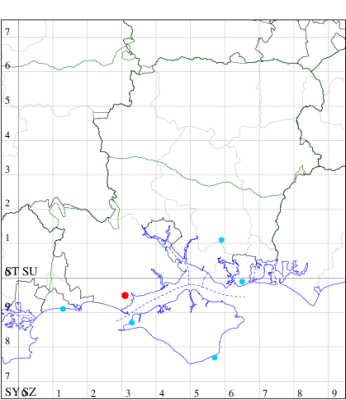
Records by year
Records by week (adult)
Records by week (larval)
Record Details
VC11: Pennington*, one, mega!, 01 Aug (RFC)
